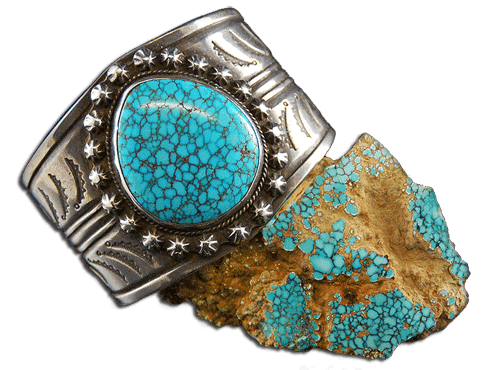American Silver Smiths
American Silversmithing Information
Classic examples of silver work have been found dating 4000 BC and beyond. American silversmithing began shortly after 1492 when the United States began colonizing. Fine examples of early American silverwork included daily living utensils, furniture hardware and adornment. History shows silver has been a precious metal used in adornment as far back in time as can be detected. It has been used as a metal of choice by peoples throughout the world for creating jewelry.
Silversmithing came to the Southwestern United States from the Spaniards. It is a general consensus that the first silversmith was Atsidi Sani (Navajo) who was introduced to silver between 1850 and 1860. In the 19th century, silver was made into items to adorn Native Americans as well as utensils to assist them in daily life. Most of these silver jewelry and utensils were crude and constructed of plain silver rather than being simular to the ever popular Turquoise Jewelry that is so prevelant today in the southwestern United States.
After the Indian war period, Native American Indian reservations came to be. Soon, traders to the Navajo realized their silverwork was one of the items that were marketable for trade. Shortly after 1800 Native American Indian Trading Posts arose and the proprietors of the Posts began encouraging the Natives to make silver adornments and utensils for trade to the settlers.
Soon after, the railroad made its way through the southwest to California. The Fred Harvey Co. as well as others set up Trading Posts to sell Indian curios and jewelry to tourists as the trains would stop for various reasons. Shortly after the turn of the century route 66 was built and went through New Mexico and Arizona and Indian Trading Posts went up one after another.
Throughout the 20th century, Native American Indian Jewelry (Navajo jewelry, Hopi jewelry, Santo Domingo Jewelry and Zuni Jewelry) became one of the prime crafts that tourists purchased while traveling through the southwest. By the 1940’s, Native American Indian Jewelry was being sold in retail store and theme parks throughout Arizona, New Mexico, California and beyond.
In the 1960’s, Native American Indian Jewelry and Turquoise had become very popular throughout the world. Turquoise became highly sot after and prospectors began searching hard for additional resources to supply the market. Turquoise was found in Arizona, Nevada, Colorado and New Mexico.

Southwestern Jewelry of Today
Jewelry supply companies and rock shops began to spring up throughout the southwest as southwestern jewelry became more and more popular. Once silver, turquoise and tools were readily available, jewelry making became a standard occupation for the Native Americans as well as Anglos and Hispanics of the southwest.
Southwestern Jewelry production shops began springing up throughout the southwest, which would be run primarily by Anglo Americans. Better control of materials, use of production techniques, and total control of the designs being made good sense to the traders. Typically, shop owners hired Native Americans as well as others to work in conjunction, in a production manner, to create the designs developed by the shop owners based on customer demand.
At the same time, individual (more artistic) Native American Silversmiths continued to work out of their own homes to create their own unique styles and designs. Collectors, then and now, seek out these individual silversmiths for their “one of a kind” pieces. Generally, “one of a kind” pieces command much great value then production shop jewelry.
In the 1970’s, there was an explosion of interest in Turquoise Jewelry of all sorts. This period brought the interest level to never seen before heights. The Southwestern Jewelry industry grew exponentially and it seemed as though there was a new gold rush.
Toward the later 1980’s, came a big shock to the industry, the outside industrial world heard there was a lot of money in the Native American Indian Craft market. They chose to copy the Santa Domingo Indian Turquoise beaded necklaces. The Santa Domingo Indians had been making turquoise beads and other gemstone beads for many years by cutting turquoise, coral, shells and other various materials into squares – drilling a hole in the center – stringing on wire – then rolling them on a grinding wheel. They had made quite an impression. Once we saw the first fake Santa Domingo necklaces they started coming into the market by the thousands. It literally destroyed the market for Santa Domingo beadwork. Look at the bead industry now –WOW! When you go to a gemshow you will not believe how many beads are there including fake turquoise beads, and Santo Domingo imitations.
Next came the Navajo Rug imposters, Navajo look a-likes were coming in from Mexico and then from the Middle East. Fortunately the fakes were and still are easy to detect, however, it still ruined the market for Navajo weavings as the fakes were cheap and overwhelmed the marketplace. Today, Navajo weavings are quickly becoming a thing of the past.
By the mid 1990’s, Navajo Jewelry had been knocked off as well. Southwest style jewelry is now being made in China, the Philippines, Korea and who knows where else.
In 2005, we find the active Native American Silversmiths along with their associated industry here in the southwest are making the finest quality jewelry since its beginning. Although there are imposters copying Southwest Designs, the Southwest artists are now learning new techniques from the imposters as well. The southwestern jewelry industry is ever growing and changing, based in Turquoise jewelry but expanding to many other gemstones and styles.
